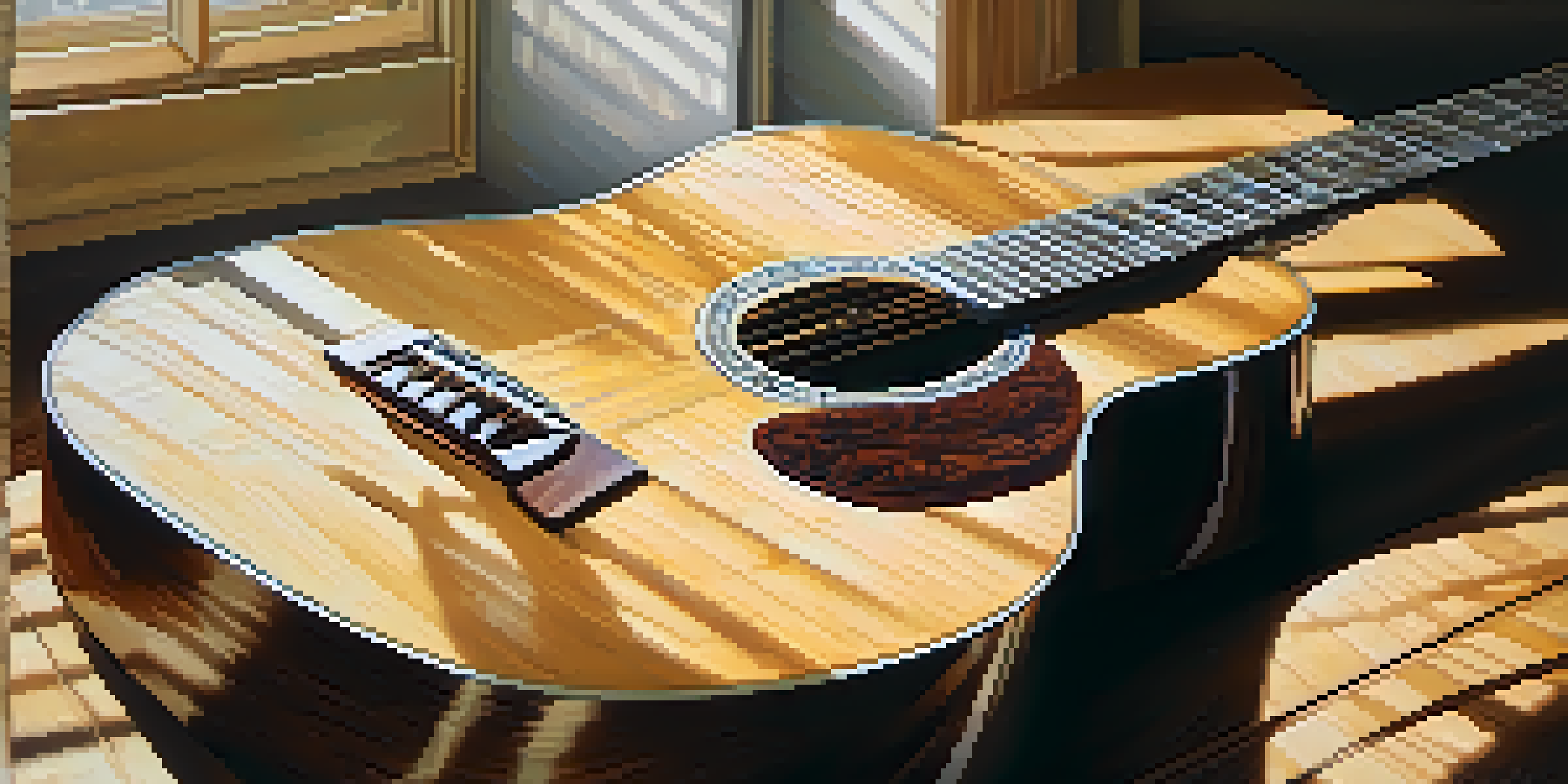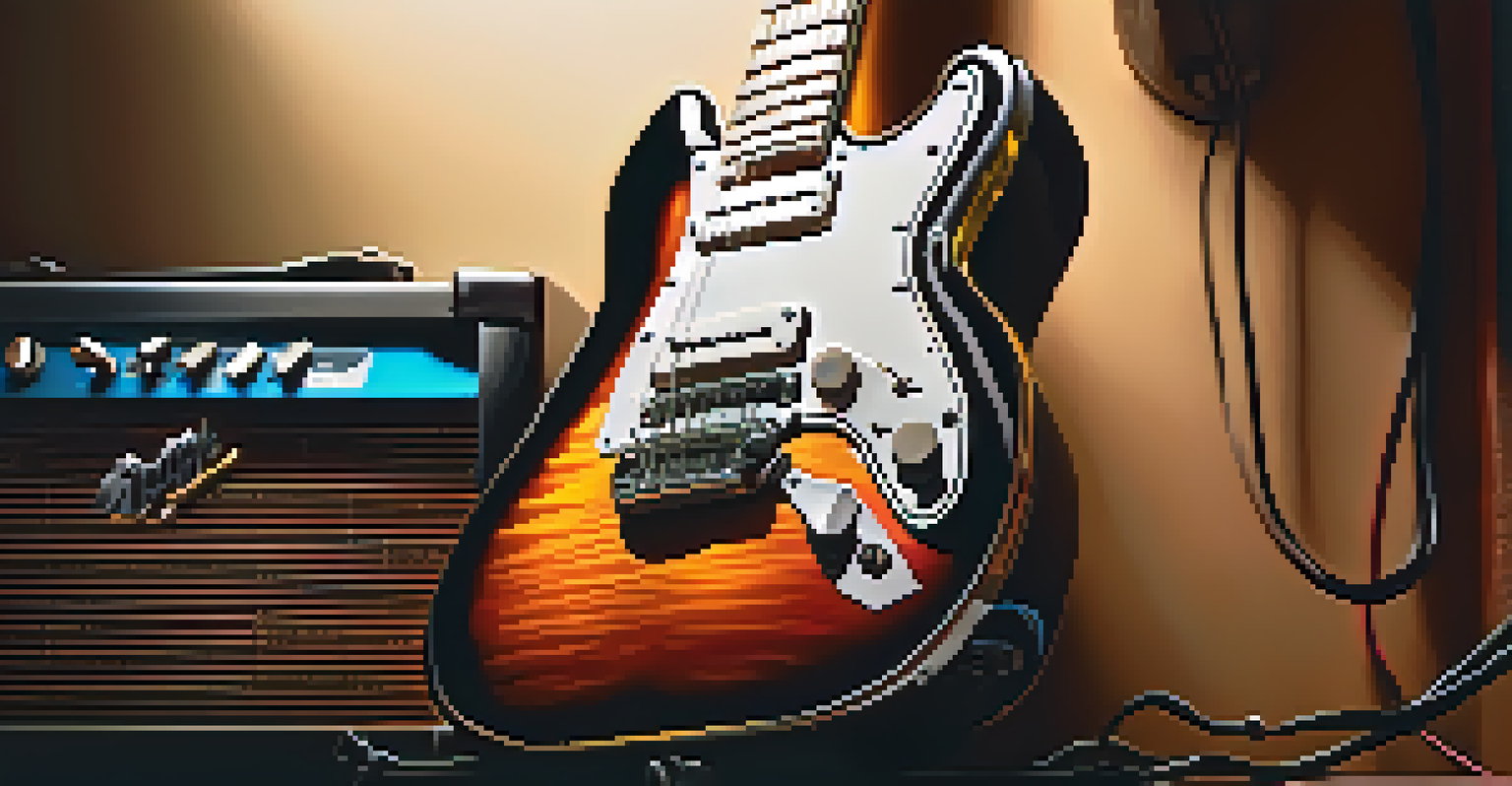Exploring the Basics of Guitar and Common Song Structures

Getting Started: Understanding Your Guitar
Before diving into playing, it's essential to familiarize yourself with your guitar. Whether you have an acoustic or electric guitar, knowing the parts—like the neck, body, and strings—can enhance your playing experience. Each part plays a vital role in producing sound, and understanding their functions can make you a more informed musician.
The beautiful thing about learning is that no one can take it away from you.
For instance, the guitar neck is where you'll be pressing the strings to create different notes, while the body amplifies the sound. If you’re using an electric guitar, the pickups are crucial as they capture the vibrations of the strings and convert them into an electrical signal. This knowledge lays the groundwork for your musical journey.
Lastly, don't forget about tuning your guitar! A well-tuned instrument is essential for sounding good, so invest in a tuner or use a tuning app. Once your guitar is in tune, you're ready to strum your first chords.
Essential Guitar Techniques for Beginners
As a beginner, mastering some fundamental techniques will set you up for success. Start with basic strumming patterns—these are the rhythms that will drive your songs forward. Practicing these patterns can help you develop a sense of timing and rhythm, which are crucial for any musician.

Another essential technique is finger positioning. Learning how to position your fingers correctly on the fretboard will make playing chords much easier. It might feel awkward at first, but with practice, your fingers will naturally find their way, allowing you to play more fluidly.
Know Your Guitar Parts
Familiarizing yourself with your guitar's parts, such as the neck and body, enhances your playing experience.
Lastly, don’t underestimate the importance of practice. Setting aside a little time each day to work on your techniques will lead to significant improvements over time. Remember, even the greatest guitarists started as beginners!
Understanding Chords: The Building Blocks of Music
Chords are the heart of most songs, and understanding them is crucial as you start playing. A chord is simply a group of notes played together, and they create the harmonic foundation of a song. Common chords like C, G, D, and E minor are your best friends as you begin your musical journey.
Music can change the world because it can change people.
You can think of chords as colors on a palette; each one adds a different flavor to your music. For example, a major chord typically sounds happy, while a minor chord can evoke a more somber feel. Experimenting with different chords can help you discover the emotional range of music.
Practicing chord transitions—moving from one chord to another—will improve your fluency and confidence. The more you practice, the smoother these transitions will become, allowing you to play songs more effortlessly.
Exploring Common Song Structures
Most songs are built around common structures, making it easier for you to write or play along. The typical structure includes verses, choruses, and bridges, each serving a unique purpose in the song. Understanding how these elements work together can help you appreciate music on a deeper level.
For example, a verse often tells a story or sets the mood, while the chorus provides a catchy hook that listeners can sing along to. The bridge, on the other hand, offers a contrast, creating a moment of tension before returning to the familiar chorus. This dynamic keeps the listener engaged throughout the song.
Master Basic Techniques
Learning fundamental techniques like strumming patterns and finger positioning is essential for beginners.
Familiarizing yourself with popular songs and their structures can be a great way to learn. Try to identify these components in songs you love, and soon you’ll be able to write your own music with ease!
The Role of Melody in Songwriting
Melody is the tune of a song, and it's what often sticks in our heads long after the music stops. It’s created by a sequence of notes played in a particular order, and it can evoke a range of emotions. Developing a strong melody is crucial for making your songs memorable.
Think of your melody as the voice of your song; it conveys the message and emotion behind the lyrics. A catchy melody can turn even simple lyrics into a hit. To practice, try humming or playing melodies on your guitar without overthinking it—let the music flow naturally.
Listening to your favorite songs can also inspire you to create your own melodies. Pay attention to how the melody interacts with the chords and lyrics, and try to incorporate similar techniques in your songwriting.
Lyrics: Crafting the Words to Your Songs
Lyrics are the soul of a song, and they can turn a simple melody into a powerful story. Writing lyrics involves expressing your thoughts, feelings, and experiences in a way that resonates with others. Whether you're writing about love, loss, or life’s adventures, authentic lyrics can create a strong connection with listeners.
One effective approach is to start with a theme or message you want to convey. From there, brainstorm words and phrases that relate to your theme. Don’t hesitate to draw inspiration from your own experiences—personal stories often make the most relatable lyrics.
Create Your First Song
Bringing together chords, melody, and lyrics allows you to craft your first song and express your unique voice.
Lastly, consider the rhythm and flow of your lyrics. Just like a melody, the way your words fit with the music matters. Play around with different phrasing until you find what feels right, and soon you'll have lyrics that complement your melodies beautifully.
Putting It All Together: Creating Your First Song
Now that you’ve learned about chords, melody, and lyrics, it’s time to bring it all together and create your first song! Start by choosing a simple chord progression to serve as the foundation. Popular progressions like C-G-Am-F are easy to play and widely used in many songs.
Next, think about the mood you want to convey and start crafting a melody that fits. You can hum or play around on your guitar until something clicks. Once you have a melody, begin writing lyrics that reflect the emotions or story you want to share.

Finally, practice playing your song from start to finish. Don’t worry if it's not perfect—every songwriter goes through a process of refinement. The more you write and play, the more your unique voice will shine through!